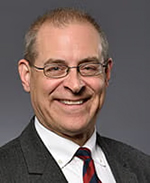Protecting the Power of the Creator
James Conley’s mpd² class focuses on the importance for product designers to legally safeguard the thoughts and plans that lead to profitable goods and services.
James Conley teaches Intellectual Capital Strategy in Northwestern Engineering's Master of Product Design and Development Management (mpd²) program. His focus is sharing insights from his career as an inventor and demonstrating the importance for those in product development to protect the seeds that become the fruits of their labor.
And to get that point across, he sometimes talks about actual fruit.
 Conley uses the example of the Honeycrisp apple to hammer home the importance of protecting a brand name. The Honeycrisp apple was first created in 1960 as a cross between two other apples as part of the University of Minnesota’s apple breeding program.
Conley uses the example of the Honeycrisp apple to hammer home the importance of protecting a brand name. The Honeycrisp apple was first created in 1960 as a cross between two other apples as part of the University of Minnesota’s apple breeding program.
The goal was to create a winter-hardy tree with high-quality fruit. The inventors at the University of Minnesota did just that – but they didn’t protect the name “Honeycrisp.” Through a patent, the university received $1.30 for every Honeycrisp tree planted, which brought in more than $8 million, before the patent expired domestically in 2008.
Since then, anyone can sell an apple under the Honeycrisp name without paying anything to the inventors.
Washington State University witnessed this blunder and made sure to not replicate it when it debuted its "Cosmic Crisp" apple. Not only did the school patent the tree, but they trademarked the name. That way, even when the patent expires, the trademark will still belong to the school and become an enduring, indefinite life source for brand building, licensing, and revenue capture.
Conley hopes case studies such as this impress upon students the importance of protecting their own thoughts and intangibles as they advance in their careers. Without learning how to protect the ownership of formative ideas, inventors can be pushed out of their own companies or miss out on windfall profits in the future.
“What surprises students in my class the most is the power that they have,” said Conley, a five-time winner of the mpd² Professor of the Year award. “Your strength doesn't come necessarily from having access to huge stacks of money or working for some big corporation. It comes from your ability to be generative.”
That lesson is especially important for mpd² students, who are at the forefront of developing new ideas for products and services long before they become something tangible in the marketplace.
Conley’s course lasts five weeks and addresses patents, copyrights, and trademarks.
“The whole idea is that the students get an exposure to all the different kinds of property rights and how they might opportunistically use them,” he said. “We look at context-specific case studies, just like we would in business school, but here, the critical asset is intellectual property.”
Conley said the hope for students when they finish his course is a solid understanding of the initial steps to take in the product development process.
Above all, he said, students need to realize that their thoughts can have tremendous value.
“They are the owners,” he said. “Use the tools of the mpd² program and come up with that new solution, and then use property as your bargaining chip in the game of value capture.”
